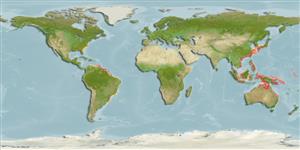>
Gobiiformes (Gobies) >
Gobiidae (Gobies) > Gobiinae
Etymology: Discordipinna: Latin, discors = to disagree + Latin, pinna = fin, wing (Ref. 45335); filamentosa: Name from Latin 'filamentum' meaning the thread-like elongation of fin; referring to its diagnostic feature, the very thin and long extension of the anterior two spinous rays of first dorsal fin..
Environment: milieu / climate zone / depth range / distribution range
Écologie
marin récifal; profondeur 30 - 82 m (Ref. 90871). Subtropical
Western Pacific: Japan and Malaysia.
Taille / Poids / Âge
Maturity: Lm ? range ? - ? cm
Max length : 1.6 cm SL mâle / non sexé; (Ref. 90871)
Description synthétique
Morphologie | Morphométrie
Épines dorsales (Total): 7; Rayons mous dorsaux (Total): 8; Épines anales 1; Rayons mous anaux: 8; Vertèbres: 26. Discordipinna filamentosa can be distinguished from D. griessingeri by the following unique set of features: D VI (vs. V), first dorsal fin with the longest, filamentous first ray in male extending far beyond caudal fin base when depressed (vs. second ray of dorsal-fin base longest in male); pectoral fin rays 16 (vs. 17-20); longitudinal scale rows 26; predorsal naked; transverse scale rows 8; dorsal pterygiophore formulae 3/122101/9 (vs. 3/41001/8); vertebrae 10 + 16 = 26; with loosely arranged, longitudinal pattern of infraorbital papilla and anterior oculoscapular canal present (with median pore ? singular on middle of interorbital region, lateral section as pores ?, ? and ?) and preopercular canal (with three pores ?, ? and ?), lacking posterior oculoscapular canal; body generally creamy white; head with a snow-white oblique band from upper lip to upper part of opercle; scattered tiny, densely-set tiny orange to brown spots on dorsal side of snout; 3 lateral, oblique orange to brown bands which generally fused ventrally on trunk; lateral body with 4-5 thin longitudinal yellow stripes; first dorsal fin yellow with 12 major transverse deep brown bands mainly on filamentous portion of the fin (vs. entirely orange red) and an oval translucent mark on basal portion of that; second dorsal fin yellow with about 4 rounded gray blotches each having a central deep black spot against yellow background; caudal fin yellow with a shallow 'C' shaped snow white mark basally and several round deep black spots on upper half; anal and pelvic fins are entirely deep black (vs. with lower 2/3 region orange red and upper 1/3 region translucent); pectoral fin with a snow-white wedge (Ref. 90871).
Collected from the deepwater trawling of up to 82 m. Observed through scuba diving and current trawl specimen record, that the species seems to live in 30 to 82 m depth water with substratum of coral-reef hard debris (Ref. 90871).
Life cycle and mating behavior
Maturité | Reproduction | Frai | Œufs | Fécondité | Larves
Chen, I.-S., T. Suzuki and K.-T. Shao, 2012. A new deepwater goby of the genus Discordipinna Hoese & Fourmanoir, 1978 (Teleostei: Gobiidae) from Kumejima of the Ryukyus, Japan. Zootaxa 3367:274-280. (Ref. 90871)
Statut dans la liste rouge de l'IUCN (Ref. 130435)
Menace pour l'homme
Harmless
Utilisations par l'homme
Plus d'informations
PaysZones FAOÉcosystèmesOccurrencesIntroductionsStocksÉcologieRégime alimentaireÉléments du régime alimentaireConsommation alimentaireRation
Noms communsSynonymesMétabolismePrédateursÉcotoxicologieReproductionMaturitéFraiRassemblement de ponteFéconditéŒufsDéveloppement de l'œuf
Taille/ÂgeCroissanceLongueur-poidsLongueur-longueurFréquences de longueursMorphométrieMorphologieLarvesDynamique des populations larvairesRecrutementAbondanceBRUVS
RéférencesAquacultureProfil d'aquacultureSouchesGénétiqueElectrophoresesHéritabilitéPathologiesTraitementNutrientsMass conversion
CollaborateursImagesStamps, Coins Misc.SonsCiguateraVitesseType de nageSurface branchialeOtolithesCerveauxVision
Outils
Articles particuliers
Télécharger en XML
Sources Internet
Estimates based on models
Preferred temperature (Ref.
123201): 21.7 - 28.1, mean 27.1 °C (based on 98 cells).
Phylogenetic diversity index (Ref.
82804): PD
50 = 0.7500 [Uniqueness, from 0.5 = low to 2.0 = high].
Bayesian length-weight: a=0.00708 (0.00333 - 0.01504), b=3.09 (2.92 - 3.26), in cm total length, based on LWR estimates for this (Sub)family-body shape (Ref.
93245).
Niveau trophique (Ref.
69278): 3.0 ±0.3 se; based on size and trophs of closest relatives
Résilience (Ref.
120179): Haut, temps minimum de doublement de population inférieur à 15 mois (Preliminary K or Fecundity.).
Fishing Vulnerability (Ref.
59153): Low vulnerability (10 of 100).
